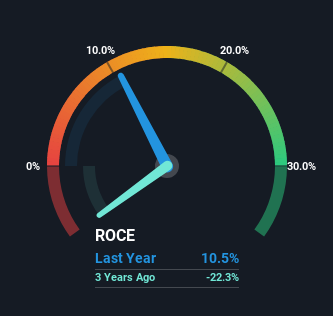Slowing Rates Of Return At Air France-KLM (EPA:AF) Leave Little Room For Excitement
Finding a business that has the potential to grow substantially is not easy, but it is possible if we look at a few key financial metrics. In a perfect world, we'd like to see a company investing more capital into its business and ideally the returns earned from that capital are also increasing. This shows us that it's a compounding machine, able to continually reinvest its earnings back into the business and generate higher returns. Having said that, from a first glance at Air France-KLM (EPA:AF) we aren't jumping out of our chairs at how returns are trending, but let's have a deeper look.
Understanding Return On Capital Employed (ROCE)
For those who don't know, ROCE is a measure of a company's yearly pre-tax profit (its return), relative to the capital employed in the business. Analysts use this formula to calculate it for Air France-KLM:
Return on Capital Employed = Earnings Before Interest and Tax (EBIT) ÷ (Total Assets - Current Liabilities)
0.10 = €1.9b ÷ (€34b - €16b) (Based on the trailing twelve months to September 2023).
Thus, Air France-KLM has an ROCE of 10%. On its own, that's a standard return, however it's much better than the 8.7% generated by the Airlines industry.
View our latest analysis for Air France-KLM

In the above chart we have measured Air France-KLM's prior ROCE against its prior performance, but the future is arguably more important. If you'd like, you can check out the forecasts from the analysts covering Air France-KLM here for free.
What Does the ROCE Trend For Air France-KLM Tell Us?
There hasn't been much to report for Air France-KLM's returns and its level of capital employed because both metrics have been steady for the past five years. This tells us the company isn't reinvesting in itself, so it's plausible that it's past the growth phase. So don't be surprised if Air France-KLM doesn't end up being a multi-bagger in a few years time.
On a side note, Air France-KLM's current liabilities are still rather high at 48% of total assets. This effectively means that suppliers (or short-term creditors) are funding a large portion of the business, so just be aware that this can introduce some elements of risk. Ideally we'd like to see this reduce as that would mean fewer obligations bearing risks.
Our Take On Air France-KLM's ROCE
We can conclude that in regards to Air France-KLM's returns on capital employed and the trends, there isn't much change to report on. Since the stock has declined 70% over the last five years, investors may not be too optimistic on this trend improving either. On the whole, we aren't too inspired by the underlying trends and we think there may be better chances of finding a multi-bagger elsewhere.
If you want to know some of the risks facing Air France-KLM we've found 3 warning signs (2 make us uncomfortable!) that you should be aware of before investing here.
While Air France-KLM isn't earning the highest return, check out this free list of companies that are earning high returns on equity with solid balance sheets.
New: Manage All Your Stock Portfolios in One Place
We've created the ultimate portfolio companion for stock investors, and it's free.
• Connect an unlimited number of Portfolios and see your total in one currency
• Be alerted to new Warning Signs or Risks via email or mobile
• Track the Fair Value of your stocks
Have feedback on this article? Concerned about the content? Get in touch with us directly. Alternatively, email editorial-team (at) simplywallst.com.
This article by Simply Wall St is general in nature. We provide commentary based on historical data and analyst forecasts only using an unbiased methodology and our articles are not intended to be financial advice. It does not constitute a recommendation to buy or sell any stock, and does not take account of your objectives, or your financial situation. We aim to bring you long-term focused analysis driven by fundamental data. Note that our analysis may not factor in the latest price-sensitive company announcements or qualitative material. Simply Wall St has no position in any stocks mentioned.
About ENXTPA:AF
Air France-KLM
Provides passenger and cargo transportation services worldwide.
Undervalued with solid track record.
Similar Companies
Market Insights
Community Narratives





